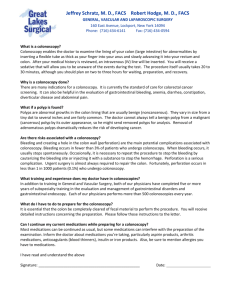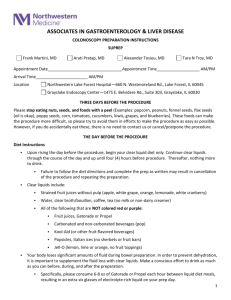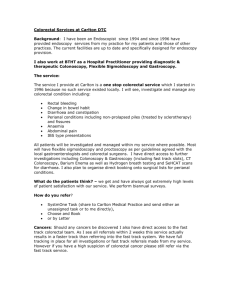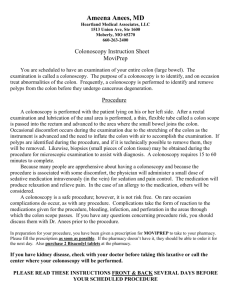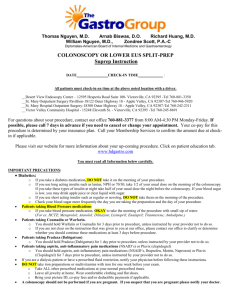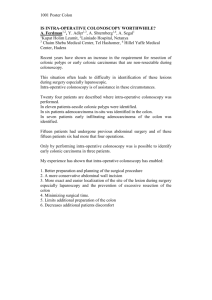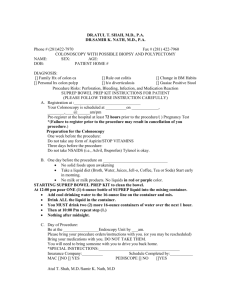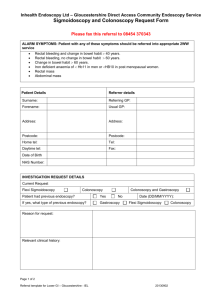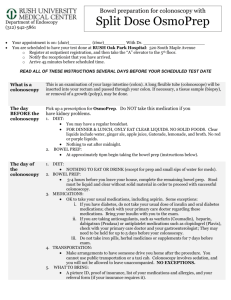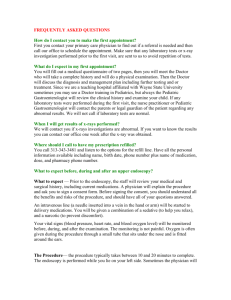Associates in Gastroenterology & Liver Disease, LLC
advertisement
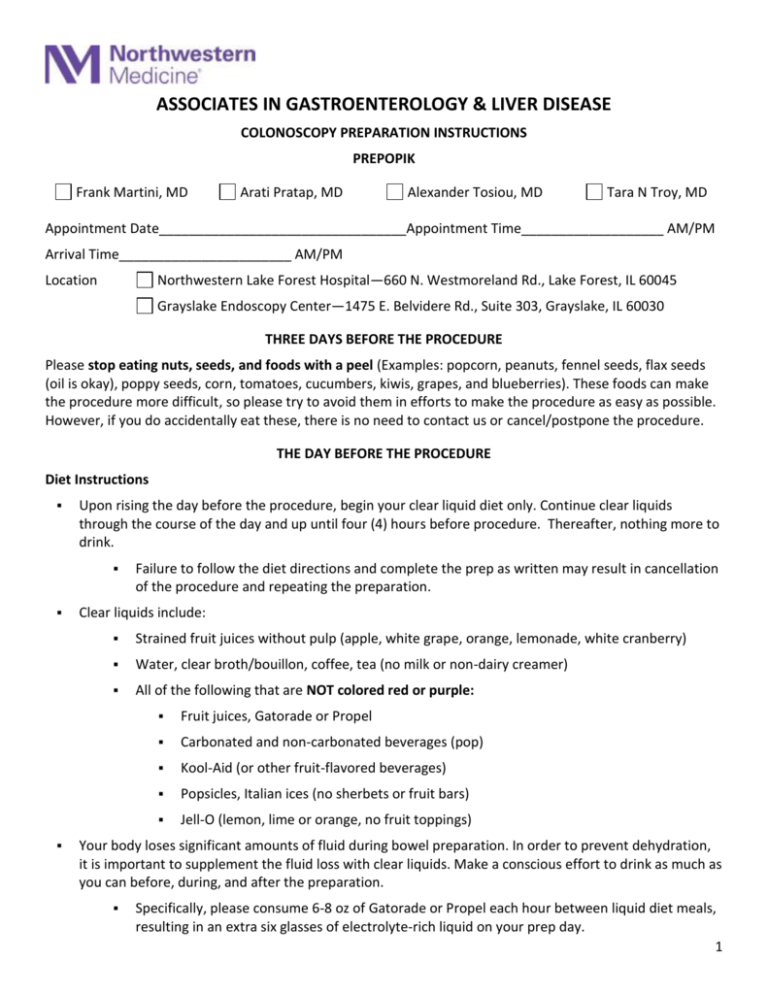
ASSOCIATES IN GASTROENTEROLOGY & LIVER DISEASE COLONOSCOPY PREPARATION INSTRUCTIONS PREPOPIK Frank Martini, MD Arati Pratap, MD Alexander Tosiou, MD Tara N Troy, MD Appointment Date_________________________________Appointment Time___________________ AM/PM Arrival Time_______________________ AM/PM Location Northwestern Lake Forest Hospital—660 N. Westmoreland Rd., Lake Forest, IL 60045 Grayslake Endoscopy Center—1475 E. Belvidere Rd., Suite 303, Grayslake, IL 60030 THREE DAYS BEFORE THE PROCEDURE Please stop eating nuts, seeds, and foods with a peel (Examples: popcorn, peanuts, fennel seeds, flax seeds (oil is okay), poppy seeds, corn, tomatoes, cucumbers, kiwis, grapes, and blueberries). These foods can make the procedure more difficult, so please try to avoid them in efforts to make the procedure as easy as possible. However, if you do accidentally eat these, there is no need to contact us or cancel/postpone the procedure. THE DAY BEFORE THE PROCEDURE Diet Instructions Upon rising the day before the procedure, begin your clear liquid diet only. Continue clear liquids through the course of the day and up until four (4) hours before procedure. Thereafter, nothing more to drink. Failure to follow the diet directions and complete the prep as written may result in cancellation of the procedure and repeating the preparation. Clear liquids include: Strained fruit juices without pulp (apple, white grape, orange, lemonade, white cranberry) Water, clear broth/bouillon, coffee, tea (no milk or non-dairy creamer) All of the following that are NOT colored red or purple: Fruit juices, Gatorade or Propel Carbonated and non-carbonated beverages (pop) Kool-Aid (or other fruit-flavored beverages) Popsicles, Italian ices (no sherbets or fruit bars) Jell-O (lemon, lime or orange, no fruit toppings) Your body loses significant amounts of fluid during bowel preparation. In order to prevent dehydration, it is important to supplement the fluid loss with clear liquids. Make a conscious effort to drink as much as you can before, during, and after the preparation. Specifically, please consume 6-8 oz of Gatorade or Propel each hour between liquid diet meals, resulting in an extra six glasses of electrolyte-rich liquid on your prep day. 1 DO NOT FOLLOW THE PREP INSTRUCTIONS ON THE PRODUCT’S BOX. YOU MUST FOLLOW OUR PREP INSTRUCTIONS AS WRITTEN BELOW. A.M. PROCEDURE INSTRUCTIONS (if your procedure is SCHEDULED BEFORE NOON) At 5:00 PM the DAY BEFORE THE PROCEDURE Fill dosing cup with water up to 5-ounce line. Pour in contents of first packet of prepopik powder. Stir for 2-3 minutes (solution may become warm as powder dissolves). Drink all the liquid in the container as soon as possible. You must also drink 5 more 8-ounce containers of water or clear liquids over the next 5 hours. At 3:00 AM the DAY OF THE PROCEDURE Fill dosing cup with water up to 5-ounce line again. Pour in contents of second packet of prepopik powder. Stir for 2-3 minutes (solution may become warm as powder dissolves). Drink all the liquid in the container as soon as possible. You must also drink 3 more 8-ounce containers of water or clear liquids over the next 5 hours. Take nothing by mouth four (4) hours before the procedure, except for blood pressure, cardiac, or thyroid medications with a sip of water. If you are scheduled very early in the morning and you are concerned you won’t have enough time to complete all fluids recommended for 3:00 AM, it is okay to start a little sooner (2:00 AM). P.M. PROCEDURE INSTRUCTIONS (if your procedure is SCHEDULED AFTER NOON) Starting at 6:00 PM the DAY BEFORE THE PROCEDURE Fill dosing cup with water up to 5-ounce line. Pour in contents of first packet of prepopik powder. Stir for 2-3 minutes (solution may become warm as powder dissolves). Drink all the liquid in the container as soon as possible. You must also drink 5 more 8-ounce containers of water or clear liquids over the next 5 hours. At 6:00 AM the DAY OF THE PROCEDURE Fill dosing cup with water up to 5-ounce line again. Pour in contents of second packet of prepopik powder. Stir for 2-3 minutes (solution may become warm as powder dissolves). Drink all the liquid in the container as soon as possible. You must also drink 3 more 8-ounce containers of water or clear liquids over the next 5 hours. Take nothing by mouth four (4) hours before the procedure, except for blood pressure, cardiac, or thyroid medications with a sip of water. 2 THE DAY OF THE PROCEDURE Before the Procedure If you are receiving sedation, PLEASE DO NOT DRINK ANY FLUIDS FOR FOUR (4) HOURS PRIOR TO THE SCHEDULED TIME OF YOUR PROCEDURE. For example, for a 7:30 AM procedure time, no fluids after 3:30 AM PLEASE ARRIVE AT THE HOSPITAL OR ENDOSCOPY CENTER ONE (1) HOUR PRIOR TO YOUR PROCEDURE’S SCHEDULED TIME, unless other instructions were given to you by your doctor. Where to go for your procedure: If you are scheduled at Lake Forest Hospital, please use the VISITOR’S ENTRANCE at the front circle drive to the Hospital. There will be a volunteer to greet you and give detailed instructions and a map directing you to the registrar. A nurse will then admit you to a Holding Area, where you will wait until your procedure begins. If you are scheduled at the Grayslake Endoscopy Center, proceed to the registration desk in the lobby. After registering, you will be directed to the third floor, Suite 303. After the Procedure Please have a family member or responsible adult REMAIN AT THE HOSPITAL OR ENDOSCOPY CENTER if you are receiving sedation. Due to the lingering effects of the sedation/anesthesia, you may not remember the physician speaking to you, so YOUR DOCTOR WILL SPEAK TO YOUR FAMILY MEMBER OR RESPONSIBLE ADULT IMMEDIATELY FOLLOWING YOUR PROCEDURE. You will be in the Recovery Area for approximately 30 to 45 minutes after your procedure. YOUR RIDE MUST REMAIN AT THE HOSPITAL OR ENDOSCOPY CENTER. DUE TO THE LINGERING EFFECTS OF THE SEDATION/ANESTHESIA, YOU MUST HAVE SOMEONE DRIVE YOU HOME. You will NOT be able to return to work after sedation/anesthesia on the day of the procedure. If additional questions, please contact us at the following: Lake Forest Hospital 660 N. Westmoreland Road, Lake Forest, Illinois 60045 (847) 234-5600 Main Hospital (847) 535-6186 GI Lab between 7:00 AM and 2:30 PM Monday through Friday Grayslake Endoscopy Center at Grayslake 1475 E. Belvidere Road (Route 120), Suite 303, Grayslake, Illinois 60030 (847) 548-8715 between 6:30 AM and 3:30 PM Monday through Friday Call (847) 295-1300 if questions or concerns after hours 3 COLONOSCOPY / EGD INSTRUCTIONS FOR DIABETIC PATIENTS IF YOUR DIABETES IS CONTROLLED WITH ORAL MEDICATIONS ONLY Schedule your Colonoscopy or EGD for a MORNING, unless otherwise instructed. Earlier is better. For Colonoscopies, take your normal medication dose on the morning of the day prior to the procedure. DO NOT take any diabetes medication after NOON. This is the day you will take your preparation. For both Colonoscopy and EGD, DO NOT take your diabetes medication before the procedure. You may take your medication after your procedure and after you have eaten. Bring your medication with you to the hospital on the day of your procedure. IF YOU TAKE INSULIN Schedule your Colonoscopy or EGD for a MORNING, unless otherwise instructed. Earlier is better. For Colonoscopies, take ½ of your normal insulin dose the day prior to the procedure. This is the day you will take your preparation. For both Colonoscopy and EGD, DO NOT take any insulin on the day of the procedure, prior to your appointment. Bring your insulin with you to the hospital on the day of your procedure. IF YOU TAKE BOTH ORAL MEDICATION & INSULIN Follow BOTH sets of instructions listed above. IF YOU HAVE AN INSULIN PUMP Schedule your Colonoscopy or EGD for a MORNING, unless otherwise instructed. Earlier is better. You MUST request specific instructions from your Endocrinologist and notify our office of those instructions PRIOR to preparing for your procedure. 4 FREQUENTLY ASKED QUESTIONS Why do you do colon cancer screening? Colorectal cancer is the second most common cause of cancer related deaths. Approximately 1 in 18 individuals will develop colorectal cancer in their lifetime. There is no way to completely eliminate the risk of developing colorectal cancer, but the systematic detection and removal of colon polyps during screening colonoscopies is the single most important intervention to reduce your risk of developing colorectal cancer. As well, early detection of colorectal cancer by screening is the best way to improve the chance of a successful cancer cure. If people took advantage of screening tests, the vast majority of deaths from colorectal cancer could be avoided. What is the purpose of the preparation? Bowel preparation for colonoscopy is so important because, unfortunately, the scope can’t see through fecal debris. So any fecal debris left in the colon could obscure identification of a polyp or even a small cancer. Several studies have shown that fewer small and large polyps are detected in patients with lessthan-optimal bowel preparation. And poor preparation has several potential consequences during the procedure itself. Second, your doctor may lack confidence that the colon lining was seen adequately and may ask you to return for a subsequent screening earlier than would be otherwise recommended – say 1 year, rather than 5 or 10 years. Lastly, if the preparation is very poor, the doctor may have to stop the procedure entirely, and you will need to reschedule and repeat the preparation. Therefore, strict adherence to the recommended bowel preparation is vital. Individual response to laxatives does vary. This prep may cause multiple bowel movements within 30-60 minutes and may take as long as three (3) hours. Please remain within easy access of toilet facilities. What if I am scheduled for a morning procedure but I have a commitment that lasts until after 5:00 p.m. on the day before the procedure, can I begin taking the preparation late (for example 6:00 p.m.)? First, your colonoscopy may last longer because the doctor will need to take time to clear out debris. How long will it take for the Prepopik to begin working? If necessary, yes. Take the second regimen 10 hours after you start the first regimen. However, keep in mind that you will likely be up later into the night using the toilet facilities. What if I have nausea or vomiting during ingestion of the preparation? Feelings of nausea, bloating, or chills are common during the preparation ingestion. This is usually temporary and will improve after the bowel movements begin. If the nausea becomes severe and you are concerned that you are going to vomit (or you do vomit), stop taking the 5 preparation for 30-60 minutes. Restart the preparation when your nausea subsides and go at a slower pace to completion. This may mean that you are awake later into the night doing the preparation, but it is preferable to you vomiting and losing the progress that you have already made. What if I have a tendency towards constipation? I have taken ALL of the preparation and 2-3 hours later my stools are still formed/solid, what should I do? No problem, your doctor will always check with you immediately before the exam about whether or not you want information to be shared with your companion. What if I am diabetic? If you are a diabetic taking oral medications or insulin, you MUST notify our office and schedule your appointment early in the morning. Please review our diabetic instruction sheet. What if I take blood thinners? Not at all. It is absolutely fine to use a tampon and/or pad. What if I don’t want clinical information shared with the ride that accompanies me? If you have a mild cold with no fever, it is okay to take Tylenol and other over the counter cold medications and proceed with the preparation and the procedure. However, if you have a fever or more severe symptoms, it may be safer to call and reschedule the procedure. Will having my period interfere with the colonoscopy? Unfortunately, going to the bathroom numerous times to cleanse your colon does often cause irritation of the anal area. Consider purchasing some baby wipes with aloe for wiping purposes and/or topical soothing cream such as Preparation H. What if I have a cold? As detailed above, the goal of the preparation is for your stools to be as close to a clear/yellow liquid as possible, though some brown/fecal material may still be present in a good quality preparation. However, formed or solid stool hours after completion of the entire preparation is concerning for a suboptimal preparation. Please call the office to speak to a physician regarding additional options. Will the preparation process cause irritation around the anal area? You may want to purchase an over the counter laxative called Miralax-OTC the week prior to the procedure. You can take 1 capful with 8 oz. of fluid daily in the week before the procedure to ensure that you are not trying to clear out a constipated colon on the night before the procedure. Please inform us if you are on Coumadin, Lovenox, Plavix, Ticlid, or any other blood thinners. Your doctor may have to adjust the dose of medication. Which medications should I take on the day of the procedure? 6 MAKE CERTAIN YOU TAKE YOUR BLOOD PRESSURE MEDICATIONS with a small sip of water. See above for information regarding diabetes medications. Other medications can be taken after the test, or if necessary, before the test with a small sip of water. If your colonoscopy has been scheduled for a screening (you have no symptoms with your bowels, such as change in bowel habits, diarrhea, constipation, rectal bleeding, anemia, etc) and your doctor finds a polyp or tissue that needs to be removed during the procedure, the colonoscopy may not be considered a screening procedure. It is considered a surgical procedure and your insurance benefits may change. You may wish to verify your benefit coverage with your insurance company. COLONOSCOPY INTRODUCTION — A colonoscopy is an examination of the lower part of the gastrointestinal tract, which is called the colon or large intestine (bowel). Colonoscopy is a safe procedure that provides information other tests may not be able to give. Colonoscopy is performed by an endoscopist, who is a physician with special training in endoscopy procedures. The colonoscope is inserted into the anus and advanced through the entire colon (to the cecum) and possibly a short distance into the small intestine. The procedure is generally between twenty and thirty minutes. PREPARATION — The endoscopy unit will provide specific instructions about how to prepare for the examination. The instructions are designed to maximize safety during and after the examination, minimize possible complications, and allow the endoscopist to fully view the colon. It is important to read the instructions ahead of time and follow them carefully; patients who have questions should speak with their healthcare provider or the endoscopy unit. The inside lining of the colon must be cleaned of stool to permit the endoscopist to complete a thorough examination. This is accomplished by restricting what is eaten and by using purgatives. Many patients say that drinking the purgative solution is the most unpleasant part of the examination. WHAT TO EXPECT — Prior to the endoscopy, a nurse will ask questions to ensure the patient understands the procedure and the reason it is planned. The nurse will start an intravenous line (insert a needle into a vein in the hand or arm) to administer medications. The intravenous line insertion feels like a pin prick, similar to having blood drawn. The vital signs (blood pressure, heart rate, and blood oxygen level) will be monitored before, during, and after the examination. The monitoring is not painful. All patients will be given oxygen during the examination. 7 THE PROCEDURE — The colonoscopy will be performed while the patient lies on their left side. Medications will be administered through the intravenous line. Most endoscopy units use a combination of a sedative (to help patients relax), and a narcotic (to prevent discomfort). Many people sleep during the examination while others are very relaxed, comfortable, and generally not aware of the examination. The colonoscope is a flexible tube, approximately the size of the index finger. It has a lens and a light source that allows the endoscopist to look into the scope or at a TV monitor. The image on the TV monitor is magnified many times so the endoscopist can see small changes in tissue. The endoscope contains channels that allow the endoscopist to obtain biopsies (small pieces of tissue), remove polyps and to introduce or withdraw fluid or air. Polyps are extra growths of tissue that can range in size from the tip of a pen to several inches (doctors measure them in millimeters and centimeters). Most polyps are benign (not cancerous) but can become cancerous if allowed to grow for a long time. As a result, they are usually removed so they can be analyzed. This does not hurt since the lining of the colon does not sense pain. Air is introduced through the scope to open up the colon so that the scope can be moved forward and to allow the endoscopist to see. Patients may experience a feeling of bloating or gas cramps from the air as it distends the colon. Try not to be embarrassed about releasing the air through the rectum; patients should let their physician know if they are uncomfortable RECOVERY — After the colonoscopy, the patient will be observed until the effects of the sedative medication are wearing off. The most common discomfort after colonoscopy is a feeling of bloating and gas cramps. Patients may also feel groggy from the sedation medications. Patients should not return to work that day. Most patients are able to eat a regular diet after the examination. TRANSPORTATION HOME — Patients need to arrange for someone to escort them safely home after the examination. Although patients will be awake by the time of discharge, the sedative medications cause changes in reflexes and judgment that cause a person to feel well but can interfere with the ability to make decisions, similar to the effect of alcohol. COMPLICATIONS — Colonoscopy is a safe procedure and complications are rare, but can occur: Bleeding can occur from biopsies or the removal of polyps, but it is usually minimal and stops quickly or can be controlled. The colonoscope can cause a tear or hole in the tissue being examined, which is a serious problem, but, fortunately, very uncommon. Adverse reactions to the medications used to sedate you are possible. The endoscopy team will ask about previous medication allergies or reactions and about health problems such as heart, lung, kidney, or liver disease. The medications can cause irritation in the vein at the site of the intravenous line. If redness, swelling, or warmth occur, applying a warm wet towel to the site may relieve the discomfort. If the discomfort persists, notify the endoscopy unit. 8 The following symptoms should be reported immediately: Severe abdominal pain (not just gas cramps) Fever Rectal bleeding (greater than a few tablespoons). AFTER COLONOSCOPY — Although patients worry about discomforts of the examination, most people tolerate it very well and feel fine afterwards. Some fatigue after the examination is common. Patients should plan to take it easy and relax the rest of the day. The endoscopist can describe the result of their examination before the patient leaves the endoscopy unit. If biopsies have been taken or polyps removed, the patient will be called with the results within one to two weeks. Use of UpToDate is subject to the Subscription and License Agreement. REFERENCES Rex, DK, Johnson, DA, Lieberman, DA, et al. Colorectal cancer prevention 2000: screening recommendations of the American College of Gastroenterology. American College of Gastroenterology. Am J Gastroenterol 2000; 95:868. Lieberman, DA, Weiss, DG, Bond, JH, et al. Use of colonoscopy to screen asymptomatic adults for colorectal cancer. Veterans Affairs Cooperative Study Group 380. N Engl J Med 2000; 343:162. Singh, H, Turner, D, Xue, L, et al. Risk of developing colorectal cancer following a negative colonoscopy examination: evidence for a 10-year interval between colonoscopies. JAMA 2006; 295:2366. 9

